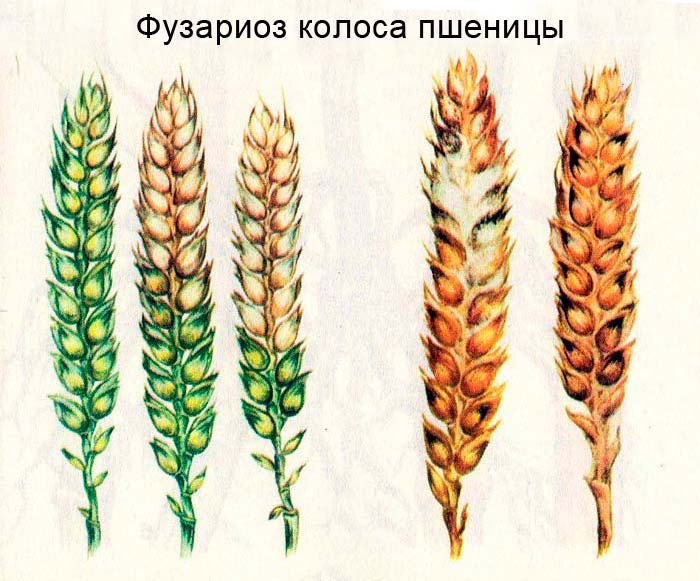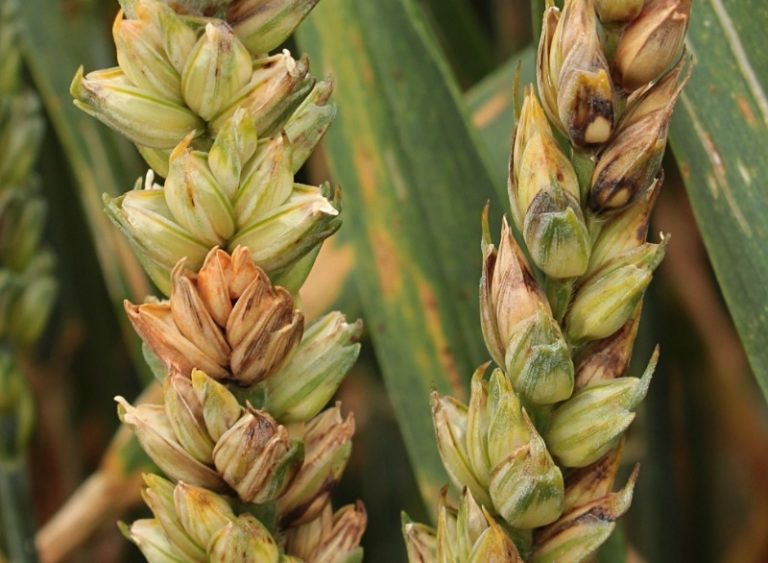What is fusarium blight on wheat and how to fight it
Such an insidious disease as fusarium blight on wheat is familiar to many farmers. However, not everyone has an idea about the reasons for its spread, development, methods of identifying and combating it.
What is fusarium blight in wheat?
Fusarium wheat - a disease caused by representatives of Fusarium fungi.
The infection slows growth, impairs the germination of winter crops, causing significant loss harvest and its qualities.
Many types of fungi produce harmful substances, as a result of which the grain becomes unfit for consumption by both humans and animals.
Kinds
Varieties:
- Fusarium head blight. An infectious disease leading to large crop losses. Makes grain unsuitable for use. The specific type of fungus depends on the geographic location and climatic conditions. For example, in the southern regions of Russia, wheat is often affected by Fusarium graminearum, and in the north - by Fusarium avenaceum.
 Fusarium head blight of wheat
Fusarium head blight of wheat - Fusarium root rot. Plants become infected during the growing season. The pathogen attacks roots, tillering nodes and the base of stems. As a result, the sprouts become infected and bushiness is reduced. An underdeveloped ear with puny grain.
- Fusarium snow mold. Fusarium nivale pathogens infect winter wheat and the disease begins after snow thaws. The infection remains on plant remains in the ground. During the growing season, it is transmitted by conidia by airborne droplets.
The causative agent of the disease
Pathogens of fusarium head blight in winter wheat are fungi from the genus Fusarium, belonging to the class Hyphomycetes, order Hyphomycetales. They infect wheat during the flowering phase, when the plant is most vulnerable. The duration of wheat flowering is only 1-2 days.
Pathogens of Fusarium root rot are hemibiotrophic parasites:
- Fusarium oxysporum;
- Fusarium subglutinans;
- Fusarium avenaceum;
- Fusarium verticilliodes;
- Fusarium solani;
- Fusarium acuminatum;
- Fusarium equiseti.
Symptoms of the lesion

Symptoms of grain fusarium:
- Unattractiveness, deformed seeds, concave furrow and sharp barrels.
- The surface of the grain is colorless, faded or pink.
- The skin is loose. Low vitreousness or its complete loss.
- The embryo is weak, dark in color.
Fusarium can affect batches of full-bodied and seemingly healthy seeds. The presence of 1 mg of mycotoxins in 1 kg of grain eliminates all its positive properties.
Symptoms of fusarium head blight:
- Dark dots appear on the scales of the ears - perithecia.
- Parts of the ear or unripe ears completely turn pale.
- Symptoms of conidial sporulation are noticeably visible on the scales: in Fusarium graminearum the pads are pink and reddish in color, in Fusarium avenaceum they are scarlet, waxy.
- The entire ear or its upper part is covered with a spore-bearing layer.
- Pads appear in leaf sheaths and at stem nodes.
- The grains have a pink tint and are puny.
- Germination weakens.
- White mycelium is visible on granaries.
In the photo - fusarium grains
Damage caused
With a strong spread of the disease, crop losses can be more than 50%, and the quality of the grain is greatly reduced.
Seeds from diseased ears are puny. If wheat contains
more than 5% of grains affected by fusarium, the concentration of the toxin exceeds the level permissible for humans and animals.
Spreading
The disease is common in all regions where grain crops are grown.
Fusarium spores are carried by the wind and infect the ear. The pathogen overwinters on the remains of vegetation from the previous harvest, as well as on infected grain.
Fighting methods
To protect wheat ears from fusarium blight, a set of measures is carried out aimed at preventing infection of the crop at the stages of vegetative development, harvesting and storage.

Chemical
The main method of combating fusarium is treating seeds with fungicides.
Effective drugs:
- "Fundazol" (benlat);
- "Opus" (epoxiconazole);
- "Impact" (flutriafol);
- "Alto" (cyproconazole);
- "Folikur" (tebuconazole);
- "Tilt" (propiconazole);
- "Rex KS" (thiophanate methyl and epoxiconazole);
- "Sportak" (prochloraz);
- "Korbel" (fenpropimorph);
- "Granit" (bromuconazole).
Processing methods:
- Dry. Mix fungicide powder with seeds. The disadvantage of this method is the uneven mixing of the product throughout the grain mass.
- Semi-dry. Etch the seeds with liquid agents (consumption - 5-10 liters per 1 ton). Moisten the grains in advance, do not dry them. The disadvantage of the method is the lack of devices to facilitate the work.
- Wet. Moisten or treat the seed with an aqueous solution of a fungicide and then dry it.
Spraying wheat in the phase of its vegetative development with drugs from the group of triazoles and benzimidazoles, which are most effective:
- "Avial". Spray once at the stage of flag leaf and ear formation. Solution consumption - 300 l/ha.
- "Amistar Extra". Spray twice during the formation of spikelets and flowering.It can be treated at the initial stage of fusarium to stop the development of the disease. Solution consumption - 300 l/ha.
- Colfugo Super. Treat 2 times during the formation of ears and the flowering phase with a solution of 300 l/ha.
- "Prosaro." Spray 1-2 times during the period of flag leaf, ear formation or at the initial stage of flowering. Solution consumption - 200-300 l/ha.
Biological
The chemical control method is complemented by biological products:
- "Planriz." Spray with the preparation at the stage of tube formation and in the flowering phase.
- "Pseudobacterin-2". Spray at the flag leaf and heading stages.
There are methods that allow you to get healthy wheat without using chemicals. For etching seed material, it is recommended to use a mixture of Trichodermin and Planriza. Wheat crops are sprayed at the initial stage of the growing season. In the phase, the tubes are processed again by adding “Becimid” (“Lepidocid”).
Agrotechnical
There are agrotechnical preventive methods:
- plowing the land;
- cleaning up plant debris;
- sowing with control of stem density.
It is necessary to clear the fields of weeds in a timely manner. This mainly concerns the cultivation of spring wheat.
Disease-resistant varieties
Soft wheat varieties, unlike hard ones, tolerate fusarium more easily.
Resistant varieties of winter wheat:
- Esaul,
- Moskvich,
- Delta,
- Father,
- Kingfisher,
- Tanya,
- Companion,
- Veda.
Spring wheat easily affected by the disease. The soft variety Svecha, which easily adapts to agroclimatic conditions, is considered more hardy.
Preventive measures
Preventive methods:
- treat the seeds with fungicides before sowing;
- plow the soil well;
- observe the norm of sowing the crop and the density of the stems;
- carry out preventive treatment of seedlings with chemicals;
- harvest on time;
- perfectly dry the crop;
- monitor humidity and temperature in warehouses;
- Before storage, pre-disinfect granaries;
- clean the field well after harvesting wheat;
- follow the rules of crop rotation;
- plant resistant varieties to reduce the likelihood of infection.
Tips and tricks from experienced farmers
Advice and recommendations from experienced specialists will help solve many issues:
- If the crop has been infected with fusarium, even apparently normal grain may contain mycotoxins. If about 5% of the crop is infected, the entire crop should be disposed of.
- If signs of Fusarium infection of wheat are found on the sown areas, it is recommended to quickly collect and dry the grain.
Useful tips:
- You cannot feed spoiled grain to animals and birds. Mycotoxins cause severe liver and kidney damage, ulcerative stomatitis, skin necrosis, and reduce reproductive function.
- It is not possible to cure a culture from a disease using traditional methods. Fusarium is a serious problem, the solution of which must be approached responsibly and use only modern methods. No folk remedy guarantees that the mycelium will not be preserved under the shell of the grains.
- The crop disease is transmitted to other cereal plants: rye, oats, barley, corn, rice. Some types of fusarium blight in wheat cause root rot of legumes.
- Crops affected by the disease can be taken to an acetone production plant or burned. It is not recommended to place them in compost pits.
Conclusion
It is very difficult to combat fusarium without following agrotechnical plant protection methods.The wide distribution of fungi, their variability, as well as the exceptional danger of mycotoxins to human and animal health make the fight against fusarium a critical part of wheat growing technology.
The search for more modern methods of fighting, based on theory and practice, continues.